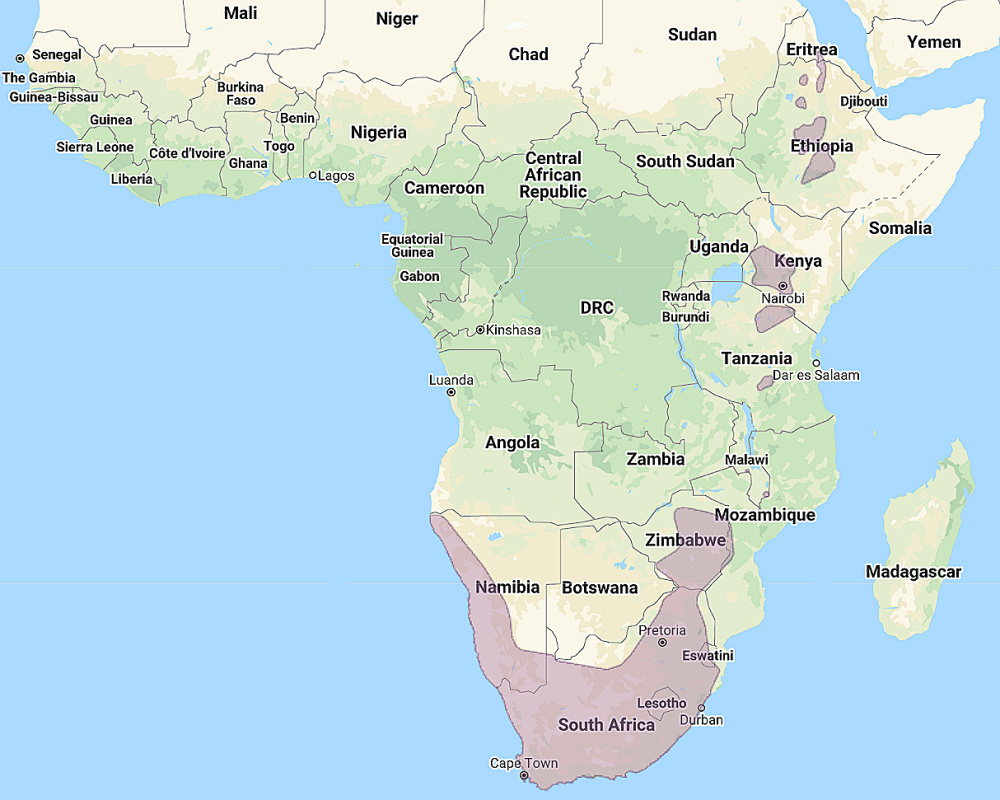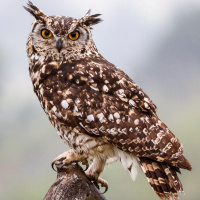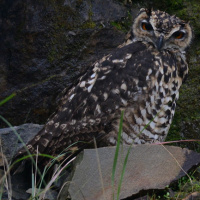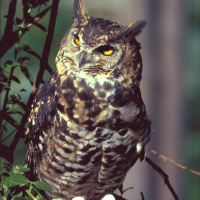Introduction
The Cape Eagle Owl is a fairly large owl with prominent ear-tufts.
Photo Gallery (3 pictures)
Sound Gallery
Information
Description: The facial disc is pale fulvous-brownish, with a distinct black or dark brown rim, which becomes broader towards the neck.
Eyes are orange-yellow to orange, the cere greyish and the bill dusky horn. Ear-tufts are prominent, and mostly dark brown, with the inner edge pale brownish.
The crown is fulvous-tawny to greyish-brown with blackish spots and mottling. Upperparts are dark brown with whitish, black and fulvous-tawny spots or mottling.
The outer webs of the scapulars have large white areas and dark dots, forming an indistinct row across the shoulder. The wing-coverts have large white spots
forming a whitish bar on the closed wing. Flight and tail feathers are barred light and dark. The throat is white.
Underparts are pale fulvous-brown, shading into whitish towards the middle of the breast and belly. The sides of the upper breast are densely blotched black,
while the rest of the underparts have some blackish spots and coarse bars.
Tarsi and toes are densely feathered. Toes are brownish on their sparsely feathered outermost tips, with bare yellowish undersides. Claws are dark horn with
blackish tips.
Size: Length 46-58cm. Wing length 330-428mm. Tail length 175-241mm. Weight 900-1800g. Females are larger and heavier than males.
Habits: The Cape Eagle Owl is a generally nocturnal bird, but may be seen occasionally after sunrise or before sunset. Roosts during the day between rocks, in crevices or holes in cliffs, in the shade of sheltered rock ledges, sometimes in trees with dense foliage, or even on the ground under a bush. May also roost on buildings if nearby. Pairs often roost together, especially before the breeding season.
Voice: The song of the male is a powerful, deep hoot, followed by a faint, short note - "Boowh-hu". This phrase is repeated at intervals of several seconds, usually from an exposed perch. The female has a slightly higher-pitched song and sometimes duets with the male. When approaching the female during courtship, the male utters a trisyllabic "cu-coo-cu" while bowing to his mate. The female gives a drawn-out, nasal, wheezing "chrrreeh" when demanding food. When alarmed, both sexes give a barking "wack wack" or "werp werp" call.
Hunting & Food: Feeds on mammals from small rodents and shrews up to the size of hares. Also feeds on birds, reptiles, frogs, scorpions,
crabs and larger insects. The majority of prey are medium-sized mammals and birds. Hunting is done from a prominent perch, the owl descending in gliding flight
and killing its victim with its powerful talons and by biting the head.
Pellets are large, measuring 68-140 x 24-35mm.
Breeding: Normally breeds once a year, sometimes only on alternate years. Cape Eagle Owls are a territorial birds, with relatively large territories. The male advertises the occupied territory by singing. During courtship, the male bows up and down in front of the upright, silent female and utters rhythmic hoots by displaying its inflated white throat in rapid sequence. The nest site is a shallow scrape on a sheltered rock ledge, or in a cave entrance, between rocks or even on the ground under a bush. Sometimes uses stick nests of larger birds in trees or tall bushes. Normally 2 (1-3) white eggs are laid directly on the nest floor at intervals of at least two days. Eggs range in size depending on subspecies, varying from 53.1 x 44.6mm average up to 57.8 x 46.5mm average. Incubation is done by the female alone, and lasts 34-38 days, during which she is fed by the male. Young hatch at intervals of up to 4 days. Their eyes open when they are 6-8 days old. The female broods the chicks, feeding them with small pieces of prey brought to the nest by the male. By 17 days old, the female is able to leave the young alone for some time, and by 3-4 weeks, she no longer stays in the nest with them, but remains close by, as does the male in the daytime. The young begin to wander away from the nest at about 45 days old. At about 70-77 days they can fly well. They are cared for up to an age of about 6 months. Sexual maturity is reached during the following year.
Habitat: Mountainous regions and hilly country with rocky areas, rocky gorges and adjacent wooded gullies. Hunts also in open savanna, and may visit local human settlements to roost and feed on feral pigeons.
Distribution: Southern Africa, with patchy distribution in East Africa north from Zimbabwe to Ethiopia and Eritrea.

Range of the Cape Eagle Owl Bubo capensis
Status: Widespread, some areas rare, while other areas frequent to common. Listed as 'Least Concern' by Birdlife International.
Original Description: Smith, Sir Andrew. 1834. South African Quarterly Journal (S. Afr. Q. J.; edited at the South African Institute) (2): p. 317.





